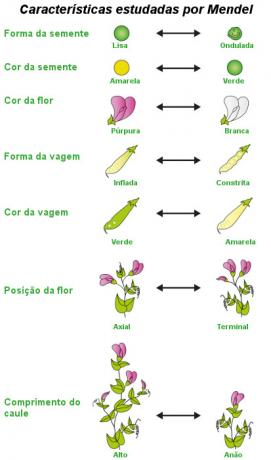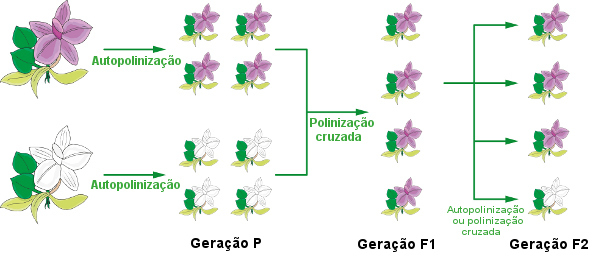THE Mendel's first law, also called Principle of Segregation of Characters or Law of Segregation, says that each characteristic is conditioned by a pair of factors that are separated in the formation of gametes. To reach this conclusion, Mendel performed a series of experiments with peas and managed to apply mathematics in his studies. Next, you will better understand this law and how Mendel came to these conclusions.
Mendel's experiment
Mendel began his experiments around 1857, when he began working with the pea cross. Peas were an important choice for the success of the experiment, as they present severalfeatures that can be studied, have a short generation time, generate a large number of offspring, in addition to being easy to grow.
To carry out his experiment, Mendel analyzed characteristics that had two distinct forms, such as green and yellow seeds, and white and purple flowers. In total, they were studied sevenfeatures: seed shape (smooth or wavy), seed color (yellow or green), flower color (purple or white), pod shape (inflated or constricted), pod color (green or yellow), flower position (axial or terminal) and stem length (high or dwarf).
In these experiments, he used plants called pure, that is, plants that, after successive generations, gave rise to plants with the same characteristic.

Mendel performed the cross-pollination of pure plants, transferring pollen from one plant to another. This cross between pure plants is called hybridization. Pure parents are called the parietal generation or P generation.
After crossing the parietal generation, the descendants of this generation were obtained, which received the name of first generationbranch or F1 generation. Crossing between F1 individuals led to the production of the second branch generation or F2 generation.
Read too: Genotype and phenotype - concepts and differences
Do not stop now... There's more after the advertising ;)
Results of Mendel's Experiments
Mendel obtained important results in his experiments with the crossing of peas. Based on the data obtained, he was able to better understand the heredity principles. To better understand Mendel's work, let's consider the cross between plants that produce purple flowers and white flowers.

Mendel crossed pure plants that had purple flowers and pure plants that had white flowers. The cross generated 100% F1 hybrids with purple flowers. The color of the flowers was exactly like that presented by pure plants, which led to the following question: what happened to the factor that determined the white color of flowers?
Mendel did not interrupt his work on the F1 generation, which was essential for understanding the process. After the result of 100% of the plants with purple flowers, he performed the fertilization between F1 plants and had a big surprise: the plants that generated white flowers reappeared.
The result presented was approximately three purple flowering plants to one white flowering plant, that is, 75% of the plants generated had purple flowers, while 25% had flowering plants white.
Read too: What is dominance and recessivity?
Mendel's Conclusions
With the results obtained, Mendel reached some important conclusions:
There are factors responsible for a particular feature. In the case of the aforementioned experiment, we can conclude that there are factors that determine the white color and the purple color. These factors are what we now know as genes and the versions of these factors are what we call an allele.
Each individual has two factors that determine a characteristic, one being inherited from the father and the other from the mother. This means that each organism inherits two alleles, one from the mother and one from the father. In the case of the F1 generation, the descendants had factors for the white flower and the purple flower.
There are dominant factors and recessive factors. Dominant alleles are able to hide or mask the recessive allele. In the case of F1 generation purple flowers, the allele for the purple color was dominant and expressed, while the allele for the white color was not. Recessive alleles are only expressed when they are paired.
Each individual passes only one factor for each feature in each gamete. This means that alleles separate during gamete formation and only one allele will be present in the gamete.
readalso: Get to know the basics in Genetics
Mendel's First Law:The characteristics of individuals are determined by pairs of factors, which are separated in the formation of gametes, with only one factor for each gamete.. |
Based on the conclusions obtained, analyze the following scheme:

Realize that purple flowers have genotype (genetic composition) PP, while the white woman has the pp genotype. As the alleles separate in the formation of gametes and combine in fertilization, we can see that, after crossing the generation P, we have 100% of the Pp genotype offspring. As the factor P is dominant over p, the plants have the color in its entirety. purple.
Possible combinations are made using the Punnet frame. In this chart, we place one individual's alleles horizontally and the other's alleles vertically. Afterwards, just join the alleles in each of the squares. To learn more about the Punnet framework, be sure to read our article on the topic: Punnet frame. |
Who was Mendel?
Gregormendel (1822-1884) was a monk who was born in a region of Austria and who stood out for his studies on heredity. He grew up on a small farm and, at the age of 21, entered the Augustinian monastery.
In 1851, Mendel left the monastery to study physics and chemistry for two years, an essential period for carrying out his experiments, as it was when he learned more about experimentation and mathematics.
Mendel returned to the monastery and around 1857, started your works with heredity, planting the peas that would be used in their work in the local garden. Mendel spent about seven years analyzing his data and assembling his conclusions.
Mendel is considered the father of genetics. |
Read too: Darwin – a big name in the theory of evolution
Solved exercises on Mendel's first law
|
(UFV) In plants Clarkia Elegans, the allele for white flowers is recessive in relation to the allele for pink flowers. Pollen from a heterozygous pink flower is placed on the pistil of a white flower. What is the proportion of expected phenotypes in the offspring? a) 1 pink: 1 white. b) 2 pink: 1 white. c) 1 pink: 2 white. d) 3 pink: 1 white. |
Resolution: LETTER A. Before answering this question, we should review some concepts. When we say that a plant is heterozygous, we are saying that it has two different alleles for that trait. Using the letter b to indicate the recessive allele that determines the white color and B to indicate the pink flower allele, we have an individual heterozygote would be Bb. The crossing between a Bb and bb (white flower) would generate 50% of pink flowering plants and 50% of white flowering plants, that is, a 1:1 ratio. See the Punnet chart below:
B |
B |
|
B |
baby |
baby |
B |
baby |
baby |
By Ma. Vanessa Sardinha dos Santos

